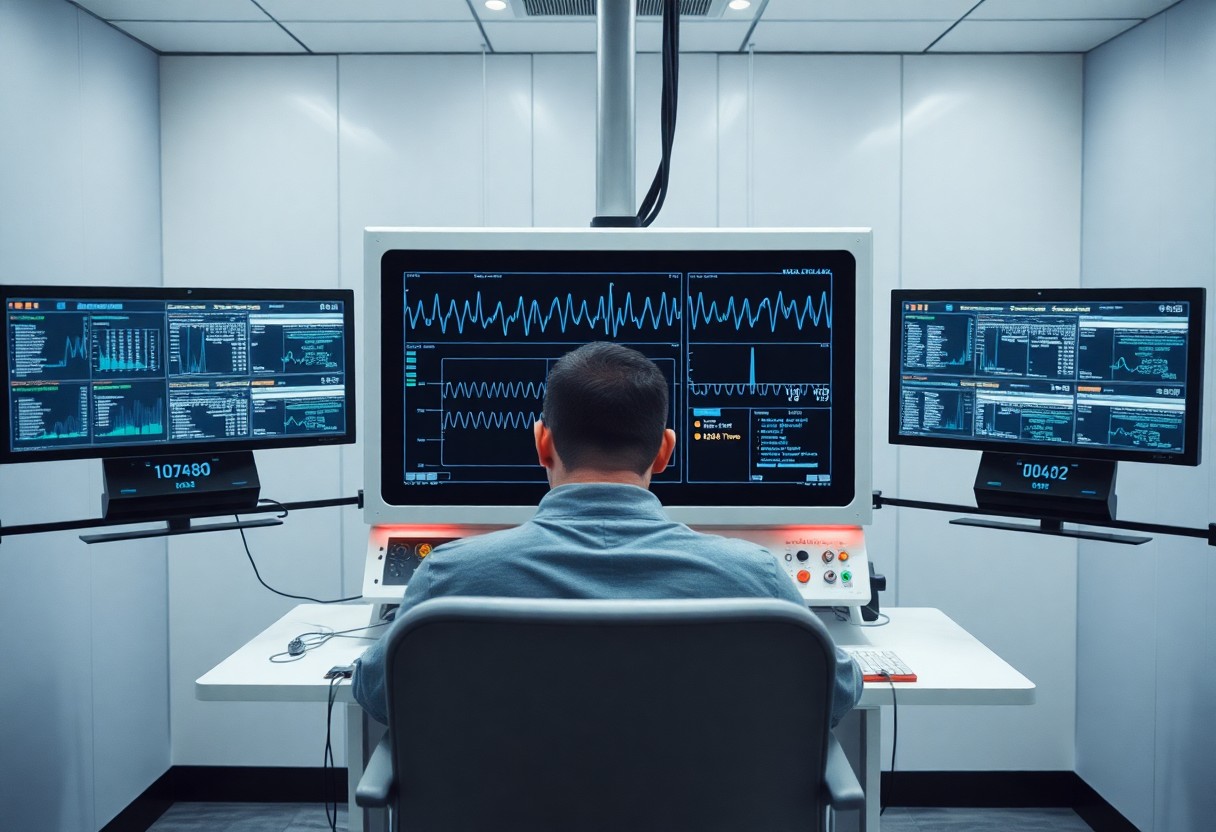
You can enhance the effectiveness of polygraphs by integrating real-time decision support systems that provide instant feedback. This technology allows you to monitor physiological responses more accurately, helping to interpret results swiftly and reliably. By implementing advanced algorithms and data analytics, you will be able to make informed decisions on the spot, significantly improving the reliability of your assessments. Staying ahead in this field requires not only understanding the technology but also effectively applying it to influence outcomes positively.
Key Takeaways:
- Integrate advanced algorithms and data analytics to enhance the real-time processing of polygraph results, ensuring immediate feedback on physiological responses.
- Utilize user-friendly interfaces for easy interaction by operators, allowing them to quickly understand and act upon the data presented during polygraph examinations.
- Incorporate training modules for personnel on how to interpret real-time data outputs effectively, ensuring accurate decision-making based on the information gathered from polygraph assessments.
1. Integrate advanced algorithms for real-time data analysis.
2. Utilize user-friendly interfaces for immediate decision-making.
3. Train personnel on effective system operation and interpretation.
4. Ensure reliable data sources for accurate feedback.
5. Implement continuous system updates for optimal performance.
6. Foster a feedback loop for ongoing system improvement.
Fundamentals of Polygraph Systems
A polygraph system is a sophisticated tool designed to measure physiological responses such as heart rate, blood pressure, respiratory pattern, and galvanic skin response while a subject answers questions. This data is then analyzed to assess truthfulness or deception during an interrogation. Understanding the fundamentals of these systems is crucial for implementing effective real-time decision support mechanisms that provide immediate feedback.
Traditional Polygraph Components
At the core of traditional polygraph systems are several key components, including the polygraph machine, sensors, and recording devices. These elements work together to monitor physiological changes and capture valuable data during the examination process. By integrating these components efficiently, you can enhance the accuracy of your results.
Real-Time Data Processing Architecture
Behind the scenes of modern polygraph systems, real-time data processing architecture plays a vital role in analyzing physiological data as it is collected. This architecture allows for instantaneous feedback, providing you with the ability to make immediate assessments based on the subject’s responses.
Further, real-time data processing architecture enables continuous monitoring of physiological signals, which is crucial for identifying inconsistencies and patterns associated with deception. By employing advanced algorithms, this architecture can filter noise, interpret raw data, and deliver actionable insights almost instantly. This quick analysis ensures that you receive timely feedback, allowing for informed decision-making during the interrogation process. Moreover, it enhances the reliability of outcomes, fostering greater confidence in the results you obtain.

Decision Support System Integration
Some organizations are now integrating real-time decision support systems into their polygraph processes, enhancing efficiency and accuracy. By leveraging advanced technology, you can access immediate insights that allow you to make informed decisions swiftly. This integration not only streamlines the administration of polygraphs but also increases the reliability of the feedback provided.
Sensor Data Collection Methods
Data collection methods play a vital role in gathering physiological indicators relevant to polygraph testing. You can utilize a variety of sensors to measure parameters such as heart rate, respiratory rate, and galvanic skin response, ensuring the quality of data collected is precise and timely.
Signal Processing Algorithms
Sensor data can contain noise and artifacts, making the use of signal processing algorithms crucial for accurate analysis. You can apply various techniques to filter, enhance, and extract meaningful patterns from the collected data, ensuring the integrity of the results you receive.
And as you implement these algorithms, you can enhance your ability to detect significant changes in physiological responses, which may correlate with deception or stress. Advanced algorithms can analyze raw data streams in real-time, allowing you to quickly interpret variations and make decisive evaluations during the examination.
Response Pattern Analysis
Against a backdrop of complex human behavior, analyzing response patterns becomes key in your decision-making process. By studying the relationship between physiological responses and behavioral indicators, you gain deeper insights into the subject’s truthfulness.
For instance, patterns of physiological changes can reveal stress levels that may indicate deception. By recognizing these trends in response patterns, you can pinpoint when a subject may be withholding information or reacting to specific questions, enhancing your ability to make accurate, informed inferences during the polygraph examination.
Real-Time Feedback Mechanisms
Despite technological advancements, implementing real-time feedback mechanisms in polygraph systems remains vital for improving accuracy and reliability. These systems allow you to instantly receive data interpretations, enabling prompt adjustments during examinations. By harnessing real-time feedback, you enhance both the efficiency and validity of your assessments, ultimately leading to more trustworthy results.
Visual Display Components
Besides standard readouts, enhancing your polygraph with advanced visual display components allows you to observe physiological signals in an intuitive manner. By integrating graphical representations, you can quickly assess the subject’s responses, making it easier to identify any inconsistencies or deviations from baseline data.
Automated Alert Systems
Along with real-time feedback, implementing automated alert systems can significantly boost your polygraph’s effectiveness. These systems notify you immediately about any suspicious responses or potential stress indicators, ensuring you stay alerted throughout the examination. Such alerts can help you focus on important details for further investigation.
In addition, automated alert systems elevate your polygraph assessments by offering you timely notifications for critical physiological changes. You can customize these alerts to reflect specific thresholds, accentuating key indicators that may require immediate attention. This proactive feature helps you intervene at the right moment, maximizing the integrity of your assessments while ensuring a more comprehensive understanding of the subject’s state. By integrating these systems, your approach enhances reliability, making every examination more effective.
Data Analysis and Interpretation
Not every analysis method is suitable for all polygraph data. To effectively equip your real-time decision support system, you must ensure that the data is processed using appropriate algorithms and techniques that can enhance accuracy. Proper interpretation of the results allows you to provide immediate feedback and make informed decisions tailored to your specific context.
Statistical Analysis Models
With the use of robust statistical analysis models, you can identify patterns and relationships in your polygraph data. These models help in quantifying the reliability of the results, ensuring that your conclusions are supported by strong statistical evidence. Employing these models enhances decision-making processes by presenting you with clear insights derived from the data.
Machine Learning Applications
Interpretation of polygraph results can greatly benefit from machine learning applications. By leveraging algorithms capable of learning from past data, you can improve accuracy in detecting patterns and discrepancies. This leads to more nuanced understanding of the subject’s physiological responses, enabling prompt and informed decision-making.
Consequently, implementing machine learning techniques within your real-time decision support system allows for adaptive learning, making it possible to enhance the detection of subtle cues in respondent data over time. These applications can analyze vast amounts of data at remarkable speeds, providing you with immediate insights and improving the overall reliability of the polygraph assessments. As a result, you are equipped to address challenging scenarios swiftly and decisively, ultimately leading to better outcomes in your assessments.
System Implementation
To successfully implement real-time decision support systems in polygraphs for instant feedback, it is important to follow a systematic approach. Start by familiarizing yourself with components of the Lafayette Polygraph System, which proves invaluable in ensuring compatibility and functionality during the integration process.
Hardware Requirements
An effective implementation of real-time decision support in polygraphs necessitates suitable hardware. Your system should include a reliable polygraph unit, necessary sensors, and a robust computer system capable of handling data processing without lags. It’s important to select quality components to enhance the accuracy of your measurements.
Software Integration
Integration of appropriate software is vital for enabling real-time feedback in your polygraph system. You will need software that can analyze data efficiently and generate visualizations, supporting fast decision-making based on physiological responses.
Also, consider that the software chosen should seamlessly connect with your existing hardware. Compatibility between systems is important to ensure data integrity and continuous operation. Take time to evaluate software on its ability to provide user-friendly interfaces, real-time analytics, and comprehensive reporting features to enhance your workflow.
Calibration Procedures
With successful system implementation comes the need for regular calibration procedures. Routine calibration is necessary to guarantee your machine’s accuracy and reliability. Make it a point to establish a consistent calibration schedule to maintain optimal performance.
Requirements include following manufacturer guidelines and utilizing specialized tools for precise measurements. Inadequate calibration can lead to misinterpretations and potentially dangerous errors in assessing physiological data. Focus on ensuring your systems are correctly calibrated to support trustworthy outcomes during evaluations.
Quality Assurance and Validation
Unlike traditional polygraph methods that may lack structure, implementing real-time decision support systems necessitates rigorous quality assurance and validation processes. Ensuring your polygraph results are accurate and reliable can be achieved by following guidelines from Evaluating Polygraph Data: A Comprehensive Analysis. Establishing a systematic approach to monitor and evaluate the performance of these systems enhances their credibility.
Testing Protocols
By adhering to established testing protocols, you can ensure that your real-time decision support systems function as intended. Clearly defined procedures and consistent application of the methodology will provide frameworks that assist in interpreting the data accurately.
Performance Metrics
At the heart of effective decision support in polygraphs are performance metrics that quantify system efficiency. Utilizing metrics such as accuracy, precision, and response time will allow you to gauge your system’s effectiveness in delivering immediate feedback.
With the application of comprehensive performance metrics, you can analyze how well your system meets predefined standards. Identifying areas for improvement is key to continually enhancing your polygraph administration and ensuring consistency in results.
System Reliability Measures
Along with performance metrics, implementing system reliability measures is vital in maintaining the integrity of your decision support systems. Regular calibration and thorough documentation of procedures will foster a trustworthy environment for data interpretation.
In addition, by assessing the frequency of system failures and implementing preventive maintenance, you enhance the overall reliability of your polygraph apparatus. This vigilance allows you to deliver dependable results and reinforce the confidence of all stakeholders involved in the assessment process.
To wrap up
As a reminder, equipping real-time decision support systems in polygraphs can significantly enhance your ability to provide instant feedback during evaluations. By integrating advanced data analytics and user-friendly interfaces, you can streamline the process of interpreting physiological data, ensuring timely and accurate insights. Utilizing machine learning algorithms can further refine your assessments, allowing for adaptable responses based on the subject’s reactions. Ultimately, by implementing these systems, you empower yourself to make informed, swift decisions that enhance the integrity and effectiveness of lie detection assessments.
FAQ
Q: What are Real-Time Decision Support Systems (DSS) and how do they apply to polygraphs?
A: Real-Time Decision Support Systems are tools that provide immediate data analysis and insights to assist in decision-making processes. When applied to polygraphs, these systems enhance the traditional lie detection methodologies by enabling instant feedback on physiological data, such as heart rate and galvanic skin response. By integrating real-time analytics, operators can better interpret responses as they occur, improving the accuracy and reliability of the polygraph results.
Q: What technologies are involved in equipping polygraphs with Real-Time Decision Support Systems?
A: Equipping polygraphs with Real-Time Decision Support Systems involves a combination of hardware and software technologies. The hardware typically includes advanced sensors that measure physiological responses with high precision. On the software side, machine learning algorithms analyze the incoming data in real-time, identifying patterns that signal potential deception. Additionally, user-friendly interfaces help operators visualize the data and receive instant alerts when critical thresholds are met, facilitating timely decision-making.
Q: What are the benefits of using Real-Time Decision Support Systems in polygraphs for instant feedback?
A: The primary benefits of utilizing Real-Time Decision Support Systems in polygraphs include enhanced accuracy in detecting deception and improved efficiency in the analysis process. Instant feedback allows examiners to adjust their questioning tactics based on physiological responses, potentially leading to a more engaging and informative session. Furthermore, this technology can assist in training and support for less experienced examiners by providing them with real-time insights and recommendations during the assessment process.
